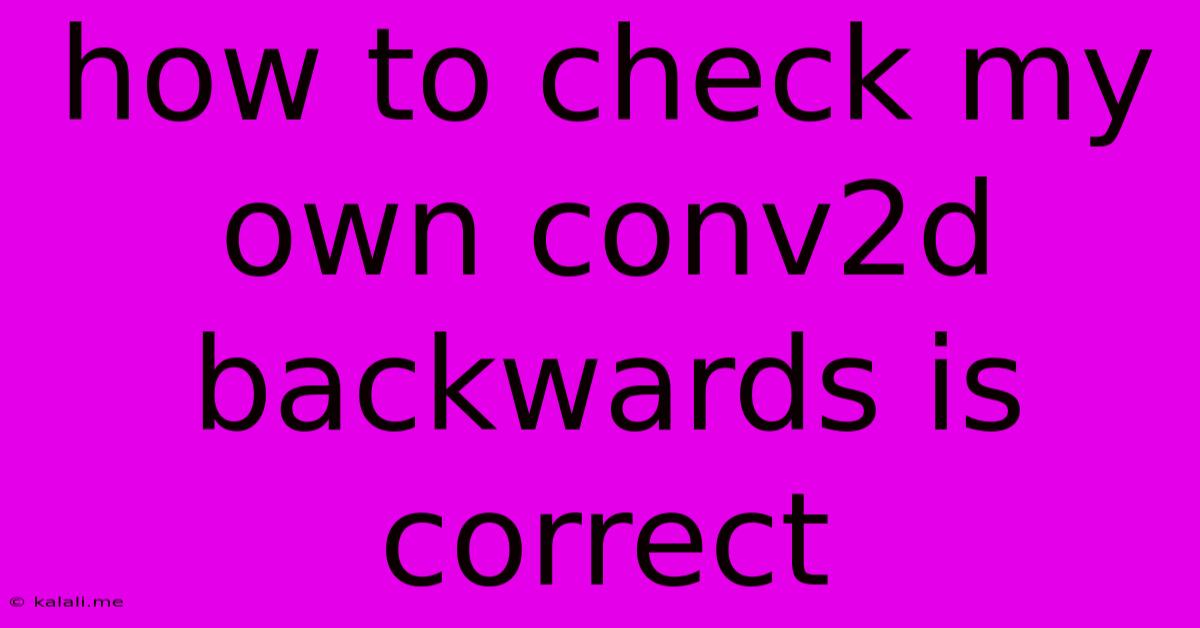How To Check My Own Conv2d Backwards Is Correct
Kalali
Jun 07, 2025 · 3 min read

Table of Contents
How to Check if Your Custom Conv2d Backpropagation is Correct
This article provides a comprehensive guide on verifying the correctness of your custom implementation of the backward pass for a 2D convolutional layer (Conv2d). Building a custom Conv2d layer, especially its backpropagation, can be tricky. This guide will equip you with techniques to ensure your implementation accurately calculates gradients, preventing subtle bugs that can derail your training process. We'll cover both theoretical understanding and practical methods for verification.
Understanding the Conv2d Backpropagation Process
Before diving into verification, let's briefly revisit the core concepts. The forward pass of a Conv2d layer involves convolving input features with learned filters (kernels) to produce output feature maps. The backward pass calculates gradients with respect to both the filters (for updating weights during training) and the input features (for backpropagation to preceding layers). These gradients are crucial for the effectiveness of gradient descent-based optimization algorithms like Adam or SGD.
The backward pass involves two main gradient calculations:
dfilters: The gradient with respect to the convolutional filters. This indicates how the filter weights should be adjusted to minimize the loss.dinput: The gradient with respect to the input features. This gradient is propagated back to the previous layer in the network.
Calculating these gradients correctly is critical. Incorrect gradients lead to incorrect weight updates and ultimately, poor model performance or even training instability.
Methods for Verifying Your Conv2d Backpropagation
Several approaches can be employed to validate your custom Conv2d backpropagation. These methods range from numerical checks to comparisons with established libraries.
1. Numerical Gradient Check (Finite Differences):
This is a fundamental technique to approximate the gradient using finite differences. It compares your calculated gradient with an approximation obtained by perturbing the input and observing the change in output. While computationally expensive, it provides a strong verification, especially for small input sizes.
The process involves:
- Calculate the output of your forward pass (
output). - Perturb a single element of your input (
input + epsilonwhereepsilonis a small value, e.g., 1e-6) and recalculate the output (output_perturbed). - Approximate the gradient component using the formula:
(output_perturbed - output) / epsilon. - Repeat this for all input elements and compare the approximated gradient with your calculated
dinput.
Similarly, you can perform this check for the filters (dfilters) by perturbing individual filter weights.
2. Comparison with Established Libraries:
The most straightforward method is to compare your results with a reliable library's implementation, such as PyTorch or TensorFlow. Implement your Conv2d layer and its backward pass. Then, run the same input through both your custom layer and the library's equivalent layer. Compare the calculated gradients (dfilters and dinput) for discrepancies. Small differences are expected due to floating-point precision limitations, but large discrepancies signal a potential error in your implementation. This comparison should be conducted for a variety of input shapes and filter sizes to ensure robustness.
3. Gradient Checking with Automatic Differentiation Libraries:
Libraries like Autograd can automatically compute gradients. You can use them to calculate the gradients for your forward pass and compare them with the gradients produced by your manual implementation. This offers a more efficient alternative to the finite differences method for larger inputs.
4. Unit Testing:
Write unit tests for your Conv2d layer's backward pass. These tests should cover various edge cases, including different input and filter sizes, padding, strides, and dilation. By systematically testing these cases, you can identify and fix potential issues early in the development process. Focus on testing scenarios that are prone to errors, such as boundary conditions or unusual input shapes.
Conclusion
Ensuring the correctness of your custom Conv2d backpropagation is crucial for successful deep learning model training. Combining multiple verification methods provides a robust approach to debugging and confirming the accuracy of your implementation. Remember that even small errors in gradient calculation can lead to significant problems later. Thorough testing and validation are essential for building reliable and high-performing models.
Latest Posts
Latest Posts
-
Offering A Hand Step Out Of Carrage Victorian Style Pose
Jun 07, 2025
-
Gta 5 Best Story Mode Cars
Jun 07, 2025
-
Why Do Cats Lick Your Hand
Jun 07, 2025
-
What Food Do Muslims Not Eat
Jun 07, 2025
-
Internal Temp Of Pork Tenderloin When Done
Jun 07, 2025
Related Post
Thank you for visiting our website which covers about How To Check My Own Conv2d Backwards Is Correct . We hope the information provided has been useful to you. Feel free to contact us if you have any questions or need further assistance. See you next time and don't miss to bookmark.